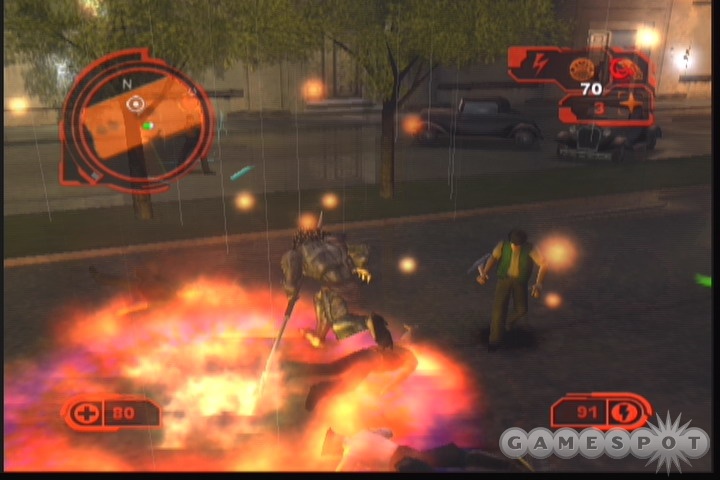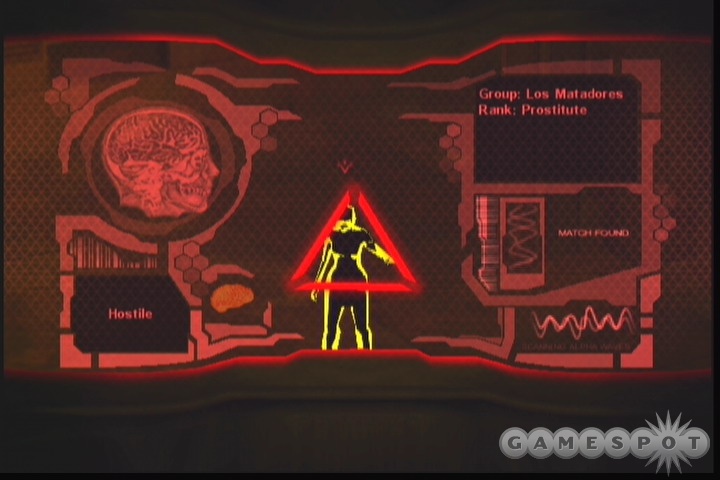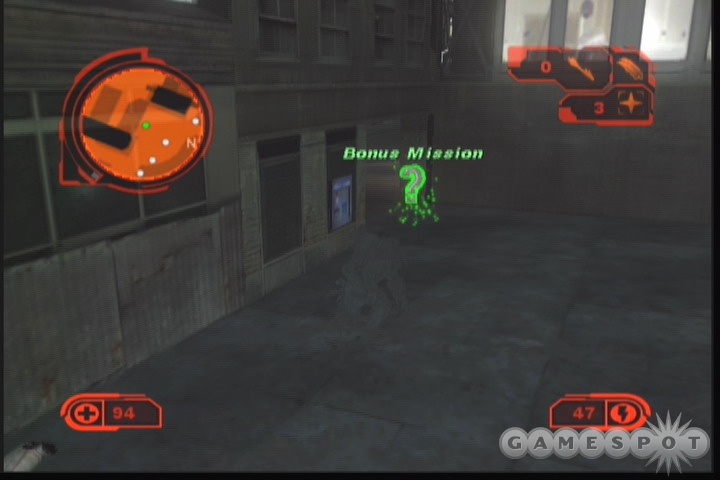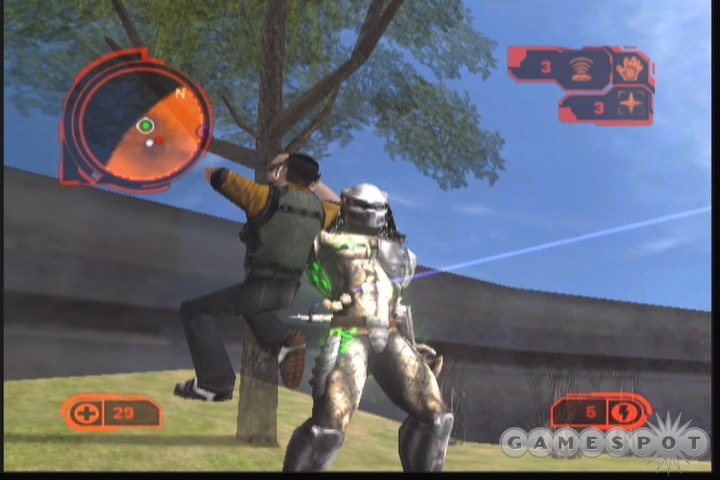Predator: Concrete Jungle Preview
We travel to the year 2030 to check out a work-in-progress Xbox version of Eurocom's upcoming action game.
You probably never heard about this in a history class, but in the year 1930 a predator went on an indiscriminate killing spree in Chicago, and in its haste to leave the planet after being discovered, it left behind a handful of its weapons. Humankind set about reverse-engineering the predator's arsenal, and 100 years later the world's major cities are overrun with gangs sporting futuristic weapons and, in some cases, cloaking devices.

In Predator: Concrete Jungle, Eurocom's upcoming action game for the Xbox and the PlayStation 2, you'll assume the role of the predator, whose carelessness caused this whole mess and who, after spending 100 years in exile as a punishment from its tribe, is sent back to Earth to atone for its past and put things right. We recently received a work-in-progress Xbox version of the game, and after playing through the first dozen or so of its 27 chapters, we're pleased to report that it has come a long way since we played it in August of last year.
The first thing you'll want to check out when playing Predator: Concrete Jungle is its training levels, which, although not particularly entertaining or challenging, do a great job of familiarizing you with the predator's movement, combat, and gadget controls. The predator is a very mobile creature, and as you play through the movement training level, you'll learn to jump great heights, hang on to ledges, scale fire escapes, perform backflips, and move hand over hand underneath certain objects. We found the Xbox controls to be quite intuitive, despite the fact that the less-than-perfectly positioned white button comes into play on more than one occasion. The all-important combat training level teaches you how to activate your wrist blades, how to target and lock on to enemies for melee attacks and one-hit kill "executions," and how to switch to the stationary first-person view for looking around and manually aiming projectile weapons. Your combat training will also teach you the difference between honorable and dishonorable kills, which basically means that you're only supposed to kill humans who are considered hostile and who are highlighted in red rather than green by your targeting reticle.

Just as important as the movement and the combat training in Predator: Concrete Jungle is the gadget training, which will familiarize you with the predator's trademark cloaking device as well as its three vision modes, which you can access simply by tapping the directional pad. In addition to your regular vision, you'll be able to use thermal vision, which lets you see hot objects in dimly lit areas or behind thin cover and also lets you scan individual targets for strengths and weaknesses; neuro vision, which shows you the mental state of individuals and highlights enemies according to their affiliation; and tech vision, which highlights recharge points (you need energy for your cloak and certain weapons), cloaked targets, and objects that you can interact with. In first-person mode, tech vision will also let you scan robots and security devices for weaknesses. All of the visual effects associated with the aforementioned gadgets are quite impressive, and you'll find that all of them come in useful as you progress through the game.
After completing your training and choosing one of three difficulty levels (you can change the difficulty at any time during the game), you'll get to play through a single level set in 1930 that gets the story up and running and lets you put your hunting skills to the test against humans who are far less challenging than those you'll face some 100 years later. As alluded to earlier, many of your enemies in the year 2030 are members of various gangs who can easily be identified by their distinctive attire. The Deadmen gang, for example, wear all black, while Les Matadores sport garish blue and yellow Mexican wrestling outfits.
Welcome to the Jungle
The layout of the game's concrete jungle is such that the gangs in it never have any opportunity to interact with each other except on occasions when it's necessary for the storyline. You'll occasionally witness gangs doing battle with riot police and their mechs, though, and since neither party is sympathetic to your cause (or to your very existence, for that matter), it's usually a good idea to let those involved do your work for you before you jump in and execute any survivors.

Many of the multiple-objective chapters that we've played through in Predator: Concrete Jungle to date have at some point required us to hunt down and kill specific enemies--a group of muggers or a citywide network of arms dealers, for example. The game throws in some pretty varied mission objectives, though, such as stalking a gang boss through the city without being seen, locating items that you'll need later in the game, and escorting an enemy through another enemy's turf. Many of the chapters also feature bonus missions that, if you find and complete them, unlock additional predator costumes and "ritual challenge" (checkpoint races against the clock, essentially) gameplay modes.
One of the things that Predator: Concrete Jungle is particularly good at is constantly forcing you to change your playing style in order to adapt to the different situations that you find yourself in. There are a lot of mission objectives that have to be completed within a time limit, for example, which makes the proceedings a lot more frantic than when you have as long as you want to stalk your prey through the sizable free-roaming cityscape in which much of the game takes place. Even the weather in the game can affect your playing style, because your cloaking device doesn't function properly in the rain.
The flip side of having to constantly change your playing style is that the game's difficulty curve is almost roller-coaster-like. Generally speaking, the missions without time limits are a lot easier than those that are played against the clock. And while almost every enemy in Predator: Concrete Jungle can be killed with one or two blows, the bosses scattered throughout the game can prove challenging on the game's default difficulty setting, particularly if you're not as well equipped to deal with them as you could be because you're low on ammo or didn't find a weapon power-up on a previous level.

Predator: Concrete Jungle is something of a mixed bag in the visuals department right now. The main character model looks great and is well animated, but other characters in the game--including plenty who get close-ups during cutscenes and such--look downright nasty. The Mexican wrestlers from Les Matadores are memorable only because they look so bad that they'd win an ugly contest against insignificant bystanders and crowd members from most other games. Most of the environments in Predator: Concrete Jungle don't compare favorably to others that you might have explored and fought in on the Xbox, but the moves at the predator's disposal make the environments a lot of fun to roam around regardless.
We've enjoyed our time with Predator: Concrete Jungle up to now, and we look forward to bringing you a full review as the game's April 26 release date approaches.
Got a news tip or want to contact us directly? Email news@gamespot.com
Join the conversation